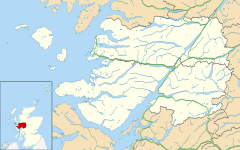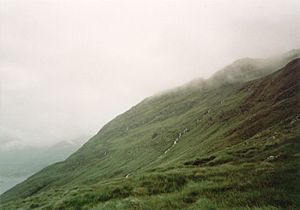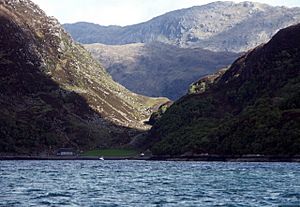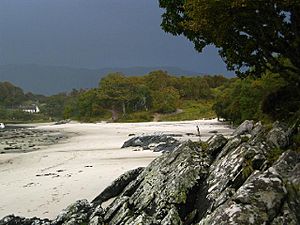Morar facts for kids
Quick facts for kids Morar
|
|
|---|---|
 Our Lady of Perpetual Succour & St Cumin, Morar |
|
| Population | 257 |
| OS grid reference | NM677929 |
| • London | 532 mi (856 km) |
| Council area | |
| Country | Scotland |
| Sovereign state | United Kingdom |
| Post town | Mallaig |
| Postcode district | PH40 |
| Dialling code | 01687 462 |
| Police | Northern |
| Fire | Highlands and Islands |
| Ambulance | Scottish |
| EU Parliament | Scotland |
Morar (pronounced "MOR-ar") is a small village located on the beautiful west coast of Scotland. It's about 3 kilometers (2 miles) south of Mallaig. The name Morar also refers to the northern part of the land around the village. The stunning coastline here is part of the Morar, Moidart and Ardnamurchan National Scenic Area. This is one of Scotland's special places, protected for its amazing views and natural beauty.
Morar has its own train station on the West Highland Line. The main road, the A830, also known as the "Road to the Isles," goes past the village. This road connects Fort William and Mallaig. The village started as a few farms and small settlements called Bourblach, Beoraid Beg, and Beoraid Mor. The modern village grew up around the railway station in the 1900s.
Contents
A Journey Through Morar's Past
Early Days and Viking Times
Long ago, after raids by Vikings, the Morar area became part of the Kingdom of the Isles. This kingdom was controlled by Norway. However, by the mid-1100s, the kingdom was split. The part that included Morar was called Garmoran, and it was ruled by a group known as the MacRory clan.
In 1266, a peace agreement called the Treaty of Perth was signed. This made Garmoran a Scottish territory, but the MacRory clan still ruled it. Eventually, the only MacRory heir was a woman named Amy of Garmoran.
Most of the rest of the Kingdom of the Isles was known as the Lordship of the Isles. It was ruled by the MacDonalds. Their leader, John of Islay, married Amy. They had three sons. Later, John divorced Amy to marry the king's niece, which brought him a lot of wealth. As part of this deal, John decided his eldest son, Ranald, would not inherit the Lordship of the Isles. Instead, Ranald was made the Lord of Garmoran.
When Ranald died at the end of the 1300s, his sons were still young. Ranald's younger brother, Godfrey, took the chance to claim the Lordship of Garmoran for himself. Also, the heirs of Ranald's other brother, Murdoch, made their own claims. This led to many fights between Godfrey's family and his brothers' families.
In 1427, King James I was tired of all the fighting in the Highlands. He called a meeting in Inverness for all the important leaders. When they arrived, many leaders were arrested. Alexander MacGorrie, Godfrey's son, was seen as one of the worst offenders. After a quick trial, he was immediately executed. Since Alexander had taken over as Lord of Garmoran, and Ranald's heirs were also involved in the violence, King James took away the Lordship from them all.
New Owners and Clan Battles
In 1469, King James I's grandson, James III, gave the lands of Garmoran and Uist to John, who was the Lord of the Isles. John then gave these lands to his half-brother, Hugh of Sleat. The king confirmed this gift in 1493. The fighting that led to Alexander's execution had almost wiped out Godfrey's family, so they no longer played a part in Morar's history.
Ranald's heirs, known as Clan Ranald, disagreed with this new ownership and fought against it. After Hugh of Sleat died in 1498, his son John gave up all authority to the king. In 1539, the king gave Morar to the MacDonells of Glengarry. This group claimed to be descendants of Ranald's son, Donald.
During the 1500s, there were many violent clashes between the MacDonells and the MacKenzies. This was due to a disagreement over land. At the end of the century, the MacKenzies tried to complain about the MacDonells in court. But the MacDonell leaders didn't show up. So, in 1602, the MacKenzies attacked Morar as punishment. This led to a big battle between the MacDonells and the MacKenzies, known as the Battle of Morar.
Later Times and Hidden Histories

The area around Morar is very important to the history of the Catholic Church in Scotland. For a long time, practicing Catholicism was against the law. There was a secret Catholic school, called a seminary, on an island in Loch Morar for a short time. But the Jacobite rising of 1715 forced it to close. It later reopened in a different location.
After the Battle of Culloden in 1746, British Navy crews searched for Jacobite soldiers who were meeting secretly on the island chapel in Loch Morar. The Jacobite leaders escaped, but the Navy continued searching caves and captured Lord Lovat. Bishop Hugh MacDonald, a Catholic leader, stayed hidden locally until he could escape to France.
In 1746, a Catholic priest named Fr. Alexander Cameron, who had helped the Jacobite army, was captured near Morar. He was held prisoner on a ship and sadly died later that year. Today, people are working to have him recognized as a Roman Catholic Saint.
During the Highland Clearances, many local people were forced to leave their homes. They moved to Canada. Boats full of Scottish Gaels left in 1790, 1802, and 1826, heading for places like Quebec, Glengarry County in Ontario, and Nova Scotia.
In 1917, a historian named Dom Odo Blundell wrote about some old church items kept at Morar. These included green robes from 1745 and a small silver cup from 1658. These items were likely used in the secret chapel on the island and were saved when the building was attacked in 1746.
People in the area remained Catholic for a long time. In the 1890s, it was said that "There was never a minister's sermon said in this country until the railway came."
During World War II, many houses in the Morar area were secretly used as training schools. Here, agents for the Special Operations Executive (SOE) learned skills for missions behind enemy lines. The Land, Sea and Islands Centre in Arisaig has an exhibit about this connection.
Morar Beach is not only famous for its history but also for movies! It was used as a filming location for the 1983 film Local Hero. It also appeared in the 1986 movie Highlander, where characters played by Sean Connery and Christopher Lambert raced along the sand. In the 1995 film Rob Roy, Morar was used to show Rob Roy MacGregor's traditional thatched house.
Famous Faces from Morar
- Alasdair mac Mhaighstir Alasdair (around 1698–1770) was a poet and teacher to Prince Charles Edward Stuart during the Jacobite rising of 1745. He wrote many famous Scottish Gaelic poems. He spent his later years near Morar. After becoming Catholic, he wrote a poem praising Bishop Hugh MacDonald and the students at the secret Buorblach Seminary.
- Rt.-Rev. Angus Bernard MacEachern (1759–1835) later became the first Bishop of the Roman Catholic Diocese of Charlottetown. He studied to become a priest at the same secret Buorblach Seminary.
- BBC weather forecaster Carol Kirkwood (born 1962) grew up in Morar.
- Fr. Alexander Macdonnell (1762–1840) was a descendant of Clan MacDonald of Glengarry. He also studied at the secret Buorblach Seminary before continuing his training in Spain. He became the first Catholic military chaplain in British history after the Reformation and the first Bishop of the Diocese of Kingston in Canada.
- Morar was a favorite winter spot for the famous English composer, Sir Arnold Bax (1883–1953), in the 1930s. He worked on several of his symphonies during his visits to the Station Hotel there.
- Cyril Kenneth Bird, known as Fougasse, lived in Morar for many years. He was a cartoonist for Punch magazine and even served as its editor.







